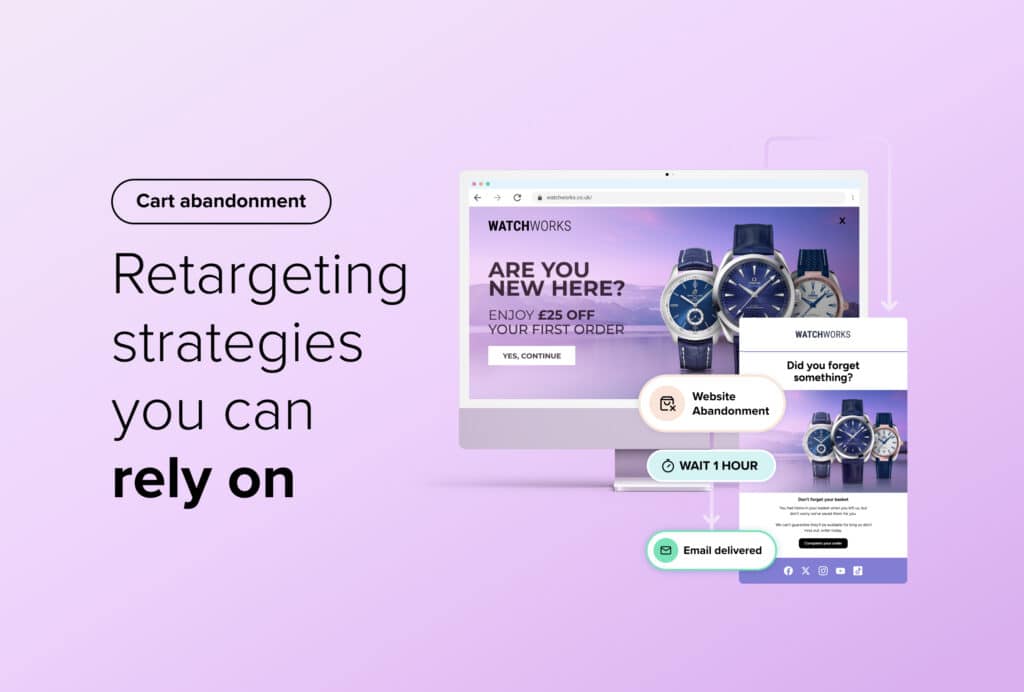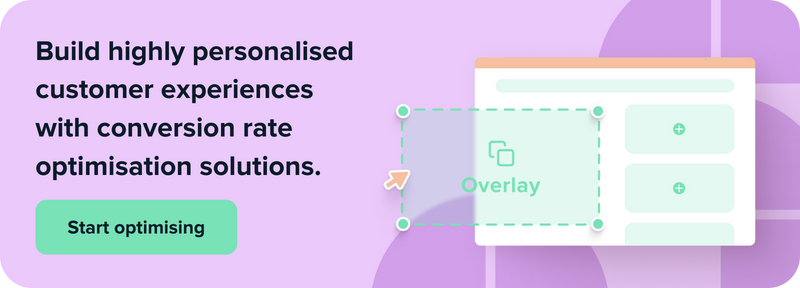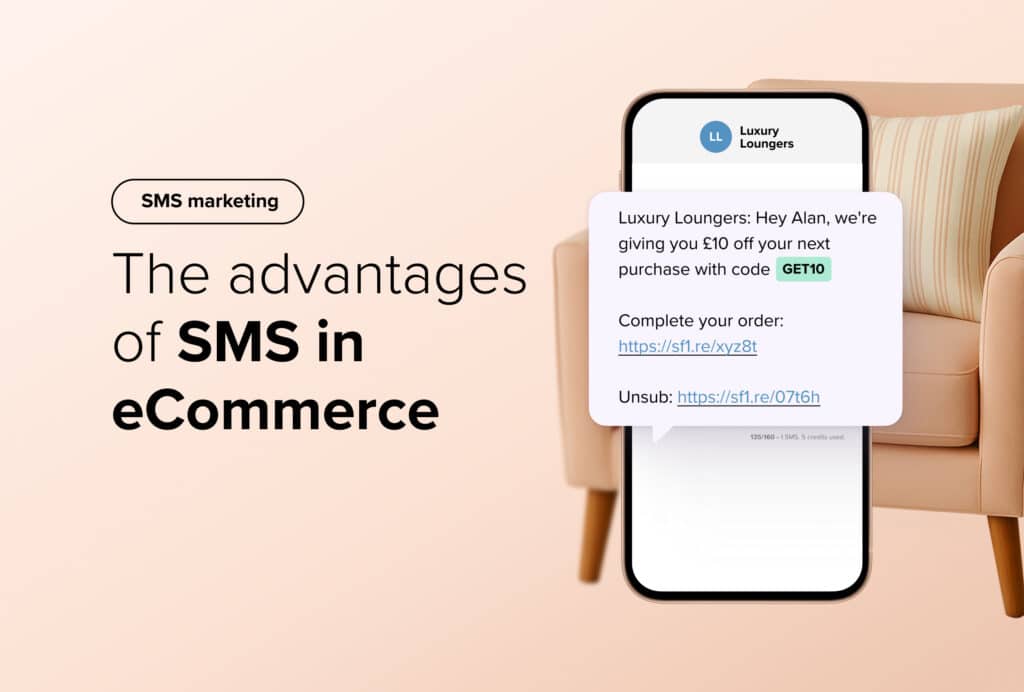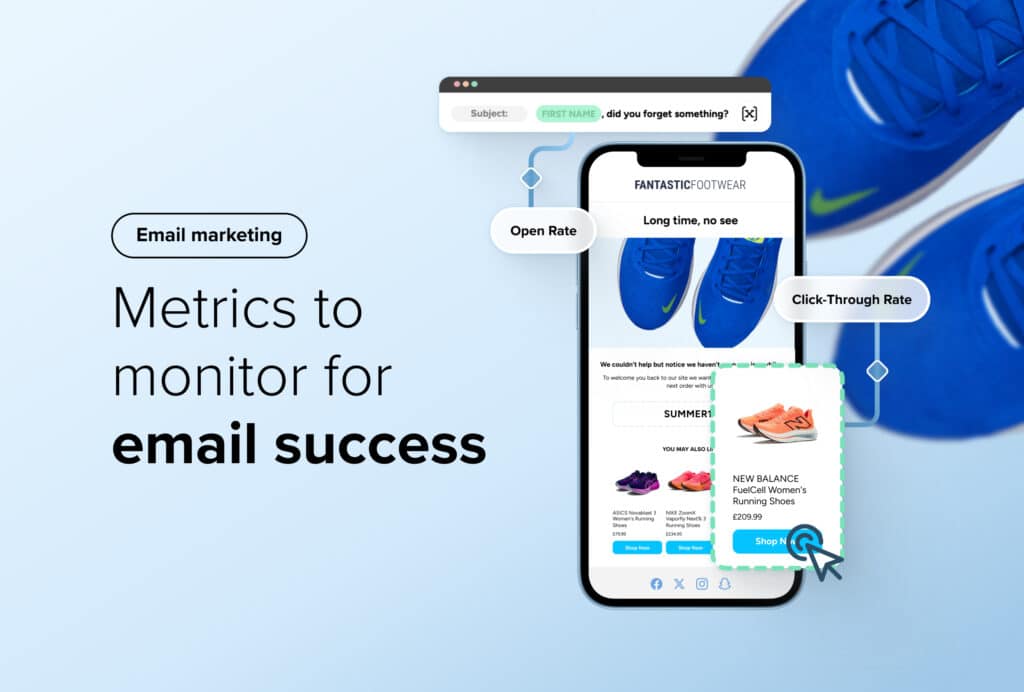How to Effectively Retarget Cart Abandoners
By Bethany Llewellyn • Last updated: Monday Jul 7th, 2025

As competition grows in the eCommerce space, tackling cart abandonment is becoming an increasingly pressing issue for online stores.
The sheer quantity of options has impacted customers’ loyalty to brands, meaning eCommerce businesses must prioritise cart retargeting strategies.
This article will take you through the key drivers of basket abandonment and the best way to recapture lost revenue for your business.

The effects of a cart abandonment strategy
Cart abandonment is a common issue faced by all online retailers, and has become a bigger concern as the eCommerce industry continues to boom.
Online stores can lose up to 75% of their sales due to cart abandoners, but with effective retargeting strategies, you can get to work on reducing your abandonment rates.1
There’s no one-size-fits-all solution, and the best way to get started with retargeting is to determine why your customers are dropping off in the first place.
There may be a whole host of reasons a shopper abandoned their items:
- Usability issues: If your site has slow load times, poor navigation or isn’t optimised for mobile, users are more likely to bounce at the checkout page.
- Poor user experience: Without an excellent user experience you risk users dropping off at the final stage since they don’t feel valued by your business.
- Doing a price comparison: For those users who are browsing for the best deal online, you can use exit-intent Overlays that are triggered when a user highlights a product title.
- Not ready to purchase: Online shoppers may just be browsing ahead of payday or aren’t ready to commit to a purchase.
This information can be used to develop strategies to reduce shopping cart abandonment, encouraging customers to return to your site and finish completing a purchase.
The battle against brick-and-mortar stores
Customers are more likely to abandon their online baskets compared to physical items in a brick-and-mortar store.
This is often because stores can utilise a tactic known as social proof: this is where they build a connection with customers through how they position products, or by encouraging customers to pick items up (thus building a stronger connection to the item).
While there are ways your eCommerce store can replicate the in-store experience, this challenge highlights the importance of preventative measures such as optimising your site and delivering a seamless online experience.
How to prevent cart abandonment
Before we get into the strategies you can put in place to retarget those shoppers who abandoned your site, why not start with preventing them from leaving in the first place?
1. Create personalised on-site experiences
Personalisation is essential for all eCommerce sites and can be the driving force behind a user shopping with you.
Not personalising the buyer’s journey will make cart abandonment more likely, as customers don’t feel looked after and won’t develop any sense of loyalty to your brand.
It can have a huge impact on your revenue since 80% of consumers are more likely to purchase from a brand that offers a personalised experience.2
Brands should aim to create personalised experiences such as:
- Including the customer’s name at the top of the page
- Offering personalised recommendations
- Providing discounts or deals based on previous purchases
- Tailoring messaging based on user interactions
These simple tailored messages can be the difference between a loyal customer and one that’s ready to abandon their cart.
With an exit-intent Overlay campaign, you can give users a shortcut to the products they want to find and showcase your latest offers and discounts, driving conversions
This can double up as a CTA to push recently viewed products and reinject them back into the sales funnel with a personalised touch.
Plus, overlays are a versatile way of enticing users to complete a purchase as you can clearly display your delivery, returns and payment options before the user heads to their basket.
Pro tip: Allow users to find specific products quicker and easier.
Utilise CRO tools like Visually Similar Search to allow users to communicate their perfect purchase, without the need for words, and inspire a new audience of shoppers.
Allowing users to shop the way they want to, whether it’s visual, voice or text search, you’ll ensure you provide an excellent experience that engages users through to the checkout.
Related: eCommerce Personalisation: What it is and how it engages users.
2. Simplify your checkout process
The best way to reduce customer drop-off at the last hurdle? Simplify your checkout process.
This goes all the way from clearly displaying shipping costs to the payment options you offer, and how you communicate this to your customers.
Since this is the last stage in the buyer’s journey, you don’t want to deter them with lengthy checkouts or the need to create an account.
Here are a few key ways you can optimise your checkout process:
- Offer guest checkouts: Don’t deter users by making them create an account with you. Guest checkouts are effective for first-time visitors or those who may have forgotten their login details to complete a purchase without the hassle.
- Provide various payment options: To instil confidence in your brand, allow shoppers to pay the way they want to. Whether it’s through buy now pay later schemes, with a credit card or PayPal, make it simpler for users to purchase with you.
- Auto-fill user details: Allow customers to auto-fill personal details like delivery addresses or payment details to prevent human error and allow for a quicker checkout.
Customers are looking for a simplified journey to purchase that requires as few steps as possible. These tips for an optimised checkout make your site more attractive to those online shoppers who are looking for a quick and seamless on-site experience.
What you can do: Implement an exit intent Overlay campaign to showcase your latest offers and discounts to deter abandoning shoppers.
This can double up as a CTA to push products they recently viewed and reinject them back into the sales funnel.
Plus, overlays are a versatile way of enticing users to complete a purchase as you can clearly display your delivery, returns and payment options before the user heads to their basket.
3. Utilise social proof
Traditional marketing was heavily reliant on word-of-mouth marketing by friends and family, but now consumers equally trust words from strangers on the internet in the form of social proof or user-generated content.
As technology has boomed over the last decade, it’s easier than ever for your brand to simply yet effectively utilise social proof on your site or social media platforms.
Start with reviews. Allow users to comment on their overall experience with your brand or with a product they recently purchased.
It will provide a sense of security and confidence, especially for new visitors, by instilling trust in your brand. As they can refer to the experience of existing customers, users are less likely to abandon their carts based on doubts they otherwise may have had.
Next, you can work on user-generated content (UGC). Your loyal customers are likely to advocate for your brand, especially when enticed through referral schemes like a discount code.
They will be able to post their items on their social media platforms which can then be repurposed in your social media strategy.
This repeat exposure to your brand will help increase your revenue from new shoppers and encourage users to complete the whole process, from product discovery to a product purchase.
Pro tip: Familiarise yourself with social proof and UGC strategies you can utilise to improve customer retention and reduce your abandonment rates.
Retargeting strategies you can implement
With an optimised customer experience and personalisation strategies in place, you’ll likely see fewer abandoning customers.
But if all else fails, you can use these strategies to reinject users back into the buyer’s funnel.
1. Leverage retargeting ads
One of the most effective ways to re-engage cart abandoners is with smart retargeting ads.
They can be served to users on a variety of social platforms, like Facebook, Instagram or Pinterest.
You can use different advertisements that showcase best sellers, recommended products or previously-viewed products and direct customers straight through to the appropriate product pages.
With dynamic ads, you can make the most of personalisation, and with a 2x higher click-through rate than traditional static ads, it’ll pay off.3
They’re extremely effective at recovering lost sales quicker, decreasing your shopping cart abandonment rate and increasing your ROI.
Here are some common ways eCommerce marketers segment their retargeting ads:
- By product: You can showcase similar products that are your store’s best sellers and pair them with creative copy that instils urgency and encourages customers to return to complete a purchase.
- By new or returning customers: Offer first-time customers a welcoming discount, or reward your loyal customers with a personalised message to make them feel valued.
- By cart value: Modify your ad spend, design and messaging based on a customer cart value to provide a tailored experience.
Regardless of how you segment your ads, you will be able to reach out to your customers in a way that best suits their wants and needs, especially if it’s targeting specific demographics.
Pro tip: You can increase the effectiveness of retargeting ads by directing users straight to their abandoned cart when they click on the ad, simplifying the whole checkout process.
2. Focus on your email retargeting
Your email marketing retargeting strategies are a tried and tested way of recovering lost purchases.
Since you have collected customer data, you have the perfect opportunity to personalise your content with a user’s name or with Recommendations based on their previous purchases or browsing behaviour.
Social proof within your email campaigns is a great way to prompt a quicker purchase. Using scarcity marketing techniques can create FOMO, such as popular items or items that are selling out fast.
Things to consider: The time you send your cart abandonment email can have a big effect on recovering a lost purchase.
1st Email: Those sent within the first-hour average a 20.3% conversion rate versus 12.2% if sent after 24 hours.
2nd Email: Those sent after 24 hours average a 17.7% conversion rate versus 7.7% if sent after 48 hours.
3rd Email: Those sent after 72 hours average an 18.2% conversion rate.4
By combining email retargeting with push notifications if you have an app, you’ll inspire users to return to your store to finish where they left off.
3. Use A/B testing and reporting
You’ve spent so much of your time and resources preventing users from abandoning your site or working on directing them back to complete a purchase – don’t let it go to waste.
Utilising smart, AI-driven technology in your retargeting campaigns will allow you to track and compare your efforts to identify opportunities for improvement.
The simplest way to collect data on your retargeting strategies is with A/B testing to see which campaigns deliver the best results.
Elements that typically change in A/B testing include:
- Email subject lines
- Calls-to-action buttons and copy
- Images
- Ad copy and imagery
You can then leverage the data to maximise your ad spend and limit costs in other areas.

Key takeaways
The ultimate goal for eCommerce teams is to prevent a user from abandoning your site in the first place.
You want to present the value of your business to them from the moment they land on your site right through to the checkout page and provide a seamless experience throughout.
Of course, cart abandonment isn’t going away anytime soon, but with appropriate retargeting campaigns, you can hugely reduce your abandonment rate.
1 Top 10 Reasons for Shopping Cart Abandonment | Barilliance
2 Epsilon research indicates 80% of consumers are more likely to make a purchase | Epsilon
3 Abandoned Cart Retargeting Ads: Everything You Need To Know | AdRoll
See how Salesfire can help you optimise your product discovery experience, email one of our experts at enquiries@salesfire.com or book a free demo of our personalisation tools.



